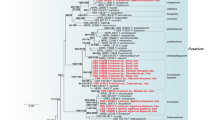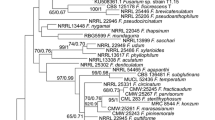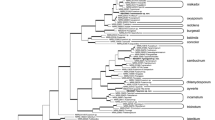Abstract
Fusarium species can have different lifestyles, including those of endophytes, parasites, or pathogens of plants, as well as pathogens or mutualists of animals. Fungicolous Fusarium species have been also reported in some studies, however, the information on the Fusarium interactions with other fungi is still unclear and the diversity of fungicolous Fusarium species is poorly known. In this study, we provide a survey of fungicolous Fusarium species and their hosts, and instructions for their isolation and identification. According to the survey, 80 fungicolous Fusarium isolates were reported associated with 36 host species and 32 fungal genera. The fungicolous isolates belong to 24 species grouped in nine species complexes (SC)—Fusarium chlamydosporum SC, Fusarium fujikuroi SC, F. heterosporum SC, F. lateritium SC, F. oxysporum SC, F. incarnatum-equiseti SC, F. sambucinum SC, F. solani SC (=Neocosmospora genus), and F. tricinctum SC. Fusarium associations with other fungi were predominantly necrotrophic. The prevalent fungal hosts for fungicolous Fusarium isolates were members of the sub-kingdom Dikarya, mostly microfungi. Other hosts belong to the sub-kingdom Mucoromyceta of the kingdom Fungi and to the phylum Oomycota (fungal-like organisms) of kingdom Straminipila. With this review, we hope to highlight the fungicolous associations of Fusarium, and to expand the understanding of the ecology and diversity of these fungi.


Similar content being viewed by others
Data Availability
The authors confirm that the data supporting the findings of this study are available within the article.
References
Leslie JF, Summerell BA (2006) The Fusarium laboratory manual. Blackwell Publishing, Ames
Lombard L, Sandoval-Denis M, Cai L, Crous PW (2019) Changing the game: resolving systematic issues in key Fusarium species complexes. Persoonia-Mol Phylogeny Evol Fungi. https://doi.org/10.3767/persoonia.2019.43.00
Aoki T, O’Donnell K, Geiser DM (2014) Systematics of key phytopathogenic Fusarium species: current status and future challenges. J Gen Plant Pathol 80:189–201
O’Donnell K, Sutton DA, Rinaldi MG et al (2010) Internet-accessible DNA sequence database for identifying fusaria from human and animal infections. J Clin Microbiol 48:3708–3718
O’Donnell K, Humber RA, Geiser DM, Kang S, Park B, Robert VARG, Crous PW, Johnston PR, Aoki T, Rooney AP, Rehner SA (2012) Phylogenetic diversity of insecticolous fusaria inferred from multilocus DNA sequence data and their molecular identification via FUSARIUM-ID and Fusarium MLST. Mycologia 104:427–445
O’Donnell K, Sutton DA, Wiederhold N et al (2016) Veterinary fusarioses within the United States. J Clin Microbiol 54:2813–2819
Van Diepeningen AD, Al-Hatmi AMS, Brankovics B et al (2014) Taxonomy and clinical spectra of Fusarium species: where do we stand in 2014? Curr Clin Microbiol Rep 1:10–18
Torbati M, Arzanlou M, Sandoval-Denis M, Crous PW (2019) Multigene phylogeny reveals new fungicolous species in the Fusarium tricinctum species complex and novel hosts in the genus Fusarium from Iran. Mycol Prog 18:119–133
Sun JZ, Liu XZ, McKenzie EHC, Jeewon R, Liu JK, Zhang XL, Zhao Q, Hyde K (2019) Fungicolous fungi: terminology, diversity, distribution, evolution, and species checklist. Fungal Divers 95(1):337–430
Vajna L (1985) Phytopathogenic Fusarium oxysporum Schlecht as a necrotrophic mycoparasite. J Phytopathol 114(4):338–347
Gams W, Diederich P, Poldamaa K (2004) Fungicolous fungi. In: Mueller GM, Bills GF, Foster MS (eds) Biodiversity of fungi inventory and monitoring methods. Elsevier Academic Press, Cambridge, pp 343–392
Gupta RC, Upadhyay RS, Rai B (1979) Hyphal parasitism and chlamydospore formation by Fusarium oxysporum on Rhizoctonia solani. Mycopathologia 67:147–152
Lira VL, Santos ACS, Tiago PV, Oliveira NT, Moura RM (2019) Hiperparasitismo de Fusarium spp. em Austropuccinia psidii em Jambo-do-Pará. Summa Phytopathol 45(2):204–206
Zare R, Khabbaz-Jolfaei H (2005) Fungi isolated from Agaricus bisporus in Tehran province with special reference to Verticillium fungicola. Rostaniha 6:17–29
Miller MA, Pfeiffer W, Schwartz T (2012) The CIPRES science gateway: enabling high-impact science for phylogenetics researchers with limited resources. In: Proceedings of the 1st Conference of the Extreme Science and Engineering Discovery Environment: Bridging from the extreme to the campus and beyond: 1–8. Association for Computing Machinery, USA.
Santos ACS, Diniz AG, Tiago PV, Oliveira NT (2020) Entomopathogenic Fusarium species: a review of their potential for the biological control of insects, implications and prospects. Fungal Biol Rev 34:41–57
Geiser DM, Jiménez-Gasco MM, Kang S, Makalowska I, Veeraraghavan N, Ward TJ, Zhang N, Kuldau GA, O’Donnell K (2004) FUSARIUM-ID v. 1.0: A DNA sequence database for identifying Fusarium. Eur J Plant Pathol 110:473–479
O’Donnell K, Sutton DA, Fothergill A, McCarthy D, Rinaldi MG, Brandt ME, Zhang N, Geiser DM (2008) Molecular phylogenetic diversity, multilocus haplotype nomenclature, and in vitro antifungal resistance within the Fusarium solani species complex. J Clin Microbiol 46:2477–2490
O’Donnell K, Nirenberg HI, Aoki T, Cigelnik E (2000) A multigene phylogeny of the Gibberella fujikuroi species complex: detection of additional phylogenetically distinct species. Mycoscience 41:61–78
Gräfenhan T, Schroers HJ, Nirenberg HI, Seifert KA (2011) An overview of the taxonomy, phylogeny, and typification of nectriaceous fungi in Cosmospora, Acremonium, Fusarium, Stilbella, and Volutella. Stud Mycol 68:79–113
Lombard L, van der Merwe NA, Groenewald JZ, Crous PW (2015) Generic concepts in Nectriaceae. Stud Mycol 80:189–245
Sandoval-Denis M, Lombard L, Crous PW (2019) Back to the roots: a reappraisal of Neocosmospora. Persoonia 43:90–185
O’Donnell K, Al-Hatmi A, Aoki T, Brankovics B, Cano-Lira JF, Coleman JJ, de Hoog GS, Di Pietro A, Frandsen RJN, Geiser DM et al (2020) No to Neocosmospora: phylogenomic and practical reasons for continued inclusion of the Fusarium solani species complex in the genus Fusarium. mSphere 5(5):e00810–e00820
Bardin S, Huang H (2001) Research on biology and control of Sclerotinia diseases in Canada. Can J Plant Pathol 23:88–98
Vajna L (1987) Fusarium lateritium Nees ex link as a parasite and host in interfungal hyphal interactions. J Phytopathol 118(2):157–164
Carrión G, Rico-Gray V (2002) Mycoparasites on the coffee rust in Mexico. Fungal Divers 11:49–60
Giferri R (1955) Observations on meliolicolous hyphales from Santo Domingo. Sydowia 9(1–6):325–326
O’Donnell K, Rooney AP, Proctor RH, Brown DW, McCormick SP, Ward TJ, Frandsen RJN, Lysøe E, Rehner SA, Aoki T, Robert VA, Crous PW, Groenewald JZ, Kang S, Geiser DM (2013) Phylogenetic analyses of RPB1 and RPB2 support a middle Cretaceous origin for a clade comprising all agriculturally and medically important fusaria. Fungal Genet Biol 52:20–31
Sandoval-Denis M, Guarnaccia V, Polizzi G, Crous PW (2018) Symptomatic citrus TREES reveal a new pathogenic lineage in Fusarium and two new Neocosmospora species. Persoonia 40:1–25
Rudakov OL (1981) Kikofil’nye Griby Ikh Biologiya i. Prakticheskoe Znachenie, Moscow, pp 1–160
Tedersoo L, Sánchez-Ramírez S, Koljalg U, Bahram M, Döring M, Schigel D, May T, Ryberg M, Abarenkov K (2018) High-level classification of the Fungi and a tool for evolutionary ecological analyses. Fungal Divers 90(1):135–159
Beakes GW, Honda D, Thines M (2014) 3 Systematics of the Straminipila: Labyrinthulomycota, Hyphochytriomycota, and Oomycota. In: McLaughlin DJ, Spatafora JW (eds) Systematics and evolution. Springer, Berlin, pp 39–97
Laurence MH, Summerell BA, Burgess LW, Liew ECY (2011) Fusarium burgessii sp. nov. representing a novel lineage in the genus Fusarium. Fungal Divers 49:101–112
Zhou X, O’Donnell K, Aoki T, Smith JA, Kasson MT, Cao ZM (2016) Two novel Fusarium species that cause canker disease of prickly ash (Zanthoxylum bungeanum) in northern China form a novel clade with Fusarium torreyae. Mycologia 108:668–681
Naranjo-Ortiz MA, Gabaldón T (2019) Fungal evolution: diversity, taxonomy and phylogeny of the fungi. Biol Rev 94:2101–2137
Summerell BA, Leslie JF (2011) Fifty years of Fusarium: how could nine species have ever been enough? Fungal Divers 50:135–144
Barnett HL, Binder FL (1973) The fungal host-parasite relationship. Annu Rev Phytopathol 11:273–292
Jeffries P (1995) Biology and ecology of mycoparasitism. Can J Bot 73:S1284–S1290
Park D, Robinson PM (1964) Isolation and bioassay of a fungal morphogen. Nature 203:988–989
Robinson PM, Park D (1965) The production and quantitative estimation of a fungal morphogen. Trans Brit Mycol Soc 48:561–571
Arora DK, Dwivedi RS (1980) Mycoparasitism off Fusarium spp. on Rhizoctonia solani Kühn. Plant Soil 55:43–53
Upadhyay HP (1981) A monograph of Ceratocystis and Ceratocystiopsis. University of Georgia Press, Athens
Mathivanan N, Prabavathy VR, Vijayanandraj VR (2008) The effect of fungal secondary metabolites on bacterial and fungal pathogens. In: Karlovsky P (ed) Secondary metabolites in soil ecology. Springer, Berlin, pp 129–140
Sajeena A, Nair DS, Sreepavan K (2020) Non-pathogenic Fusarium oxysporum as a biocontrol agent. Indian Phytopathol 73:177–183
Sneh B, Humble SJ, Lockwood JL (1977) Parasitism of oospores of Phytophthora megasperma var. sojae, P. cactorum, Phytium sp. and Aphanomyces euteiches in soil by oomycetes, chytridiomycetes, hyphomycetes actinomycetes and bacteria. Phytopathology 67:622–628
Wynn AR, Epton HAS (1979) Parasitism of oospores of Phytophthora erythroseptica in soil. Trans Brit Mycol Soc 73:255–259
Rao NNR, Pavgi MS (1976) A mycoparasite on Sclerospora graminicola. Can J Bot 54:220–223
Hornok L, Walcz I (1983) Fusarium heterosporum, a highly specialized hyperparasite of Claviceps purpurea. Trans Brit Mycol Soc 80:377–380
Dubey RC, Dwivedi RS (1986) Destructive mycoparasitic behaviour of Fusarium solani (Mart.) App. and Woll. against Mucor spinosus Van Tieghem. Microbiol Lett 32:123–127
Mathivanan N, Kabilan V, Murugesan K (1998) Purification, characterization, and antifungal activity of chitinase from Fusarium chlamydosporum, a mycoparasite to groundnut rust, Puccina arachidis. Can J Microbiol 44:646–651
Wollenweber HW, Reinking OA (1935) Die Fusarien, ihre Beschreibung, Schadwirkung und Bekämpfung. Paul Parey, Berlin
Torbati M, Arzanlou M (2020) Mushroom forming fungi as possible reservoir hosts for Phaeoacremonium species: first occurrence of Phaeoacremonium fraxinopennsylvanicum on Flammulina velutipes s. lato. Nova Hedwigia 110(3–4):383–394
Hajek AE, Longcore JE, Simmons DR, Peters K, Humber RA (2013) Chytrid mycoparasitism of entomophthoralean azygospores. J Invertebr Pathol 114:333–336
Hadar Y, Papadopoulou KK (2012) Suppressive composts: microbial ecology links between abiotic environments and healthy plants. Annu Rev Phytopathol 50:133–153
Crous PW, Verkley GJM, Groenewald JZ, Samson RA (2009) Fungal biodiversity. CBS laboratory manual series 1. Centraalbureau voor Schimmelcultures, Utrecht, pp 1–269
Snyder WC, Hansen HN (1947) Advantages of natural media and environments in the culture of fungi. Phytopathology 37:420–421
Rayner RW (1970) A mycological colour chart. CMI and British Mycological Society, England
Kornerup A, Wanscher JH (1978) Methuen handbook of colour. Methuen, London, p 248
Fisher NL, Burguess LW, Toussoun TA, Nelson PE (1982) Carnation leaves as a substrate and for preserving cultures of Fusarium species. Phytopathology 72:151–153
Nirenberg HI (1976) Untersuchungen über die morphologische und biologische Differenzierung in der Fusarium-Sektion Liseola. Mitteilungen der Biologischen Bundesanstalt für Land-und Forstwirtschaft Berlin-Dahlem 169:1–117
Moretti AN (2009) Taxonomy of Fusarium genus: a continuous fight between lumpers and splitters. Zbornik Matice srpske za prirodne nauke 117:7–13
Samuels GJ, Nirenberg HI, Seifert KA (2001) Perithecial species of Fusarium. In: Summerell BA, Leslie JF, Backhouse D, Bryden WL (eds) Fusarium: Paul E Nelson memorial symposium. APS Press, USA, pp 1–14
Zeller KA, Summerell BA, Bullock S, Leslie JF (2003) Gibberella konza (Fusarium konzum) sp. nov. from prairie grasses, a new species in the Gibberella fujikuroi species complex. Mycologia 95:943–954
Lima CS, Pfenning LH, Costa SS, Abreu LM, Leslie JF (2012) Fusarium tupiense sp. nov., a member of the Gibberella fujikuroi complex that causes mango malformation in Brazil. Mycologia 104:1408–1419
Santos ACS, Trindade JVC, Lima CS, Barbosa RN, Costa AF, Tiago PV, Oliveira NT (2019) Morphology, phylogeny and sexual stage of Fusarium caatingaense and Fusarium pernambucanum, new species of the Fusarium incarnatum-equiseti species complex associated with insects in Brazil. Mycologia 111:244–259
Park B (2013) Cyber-infrastructure supporting fungal and oomycete phylogenetics and genomics. Ph.D. Dissertation, Pennsylvania State University
O’Donnell K, Ward TJ, Robert VARG, Crous PW, Geiser DM, Kang S (2015) DNA sequence-based identification of Fusarium: current status and future directions. Phytoparasitica 43:583–595
O’Donnell K, Kistler HC, Cigelnik E et al (1998) Multiple evolutionary origins of the fungus causing Panama disease of banana: concordant evidence from nuclear and mitochondrial gene genealogies. Proc Natl Acad Sci USA 95:2044–2049
O’Donnell K, Sutton DA, Rinaldi MG, Gueidan C, Crous PW, Geiser DM (2009) Novel multilocus sequence typing scheme reveals high genetic diversity of human pathogenic members of the Fusarium incarnatum-F. equiseti and F. chlamydosporum species complexes within the united states. J Clin Microbiol 47:3851–3861
Navi SS, Singh SD (1993) Fusarium longipes-a mycoparasite of Sclerospora graminicola on pearl millet. Indian Phytopathol 46:365–368
Mathivanan N, Murugesan K (2000) Fusarium chlamydosporum, a potent biocontrol agent to groundnut rust Puccinia arachidis. J Plant Dis Prot 107(3):225–234
Domsch KH, Gams W, Anderson T (2007) Compendium of soil fungi, 2nd edn. IHW-Verlag, Germany, pp 1–672
Bakshi S, Sztejnberg A, Yarden O (2001) Isolation and characterization of a cold-tolerant strain of Fusarium proliferatum, a biocontrol agent of grape downy mildew. Phytopathology 91:1062–1068
Acknowledgements
The Research Deputy of the University of Tabriz and Iranian Mycological Society are kindly acknowledged. Ana Carla da Silva Santos thanks the Fundação de Amparo a Ciência e Tecnologia do Estado de Pernambuco (FACEPE)—Brazil for postdoctoral fellowship.
Author information
Authors and Affiliations
Contributions
ACSS conceived and designed the idea for the article. MT performed the literature search and data collection. MA supervised and revised the work. All authors wrote, read and approved the manuscript.
Corresponding author
Ethics declarations
Conflict of interest
The authors declared that they have no conflict of interest.
Additional information
Publisher's Note
Springer Nature remains neutral with regard to jurisdictional claims in published maps and institutional affiliations.
Rights and permissions
About this article
Cite this article
Torbati, M., Arzanlou, M. & da Silva Santos, A.C. Fungicolous Fusarium Species: Ecology, Diversity, Isolation, and Identification. Curr Microbiol 78, 2850–2859 (2021). https://doi.org/10.1007/s00284-021-02584-9
Received:
Accepted:
Published:
Issue Date:
DOI: https://doi.org/10.1007/s00284-021-02584-9




